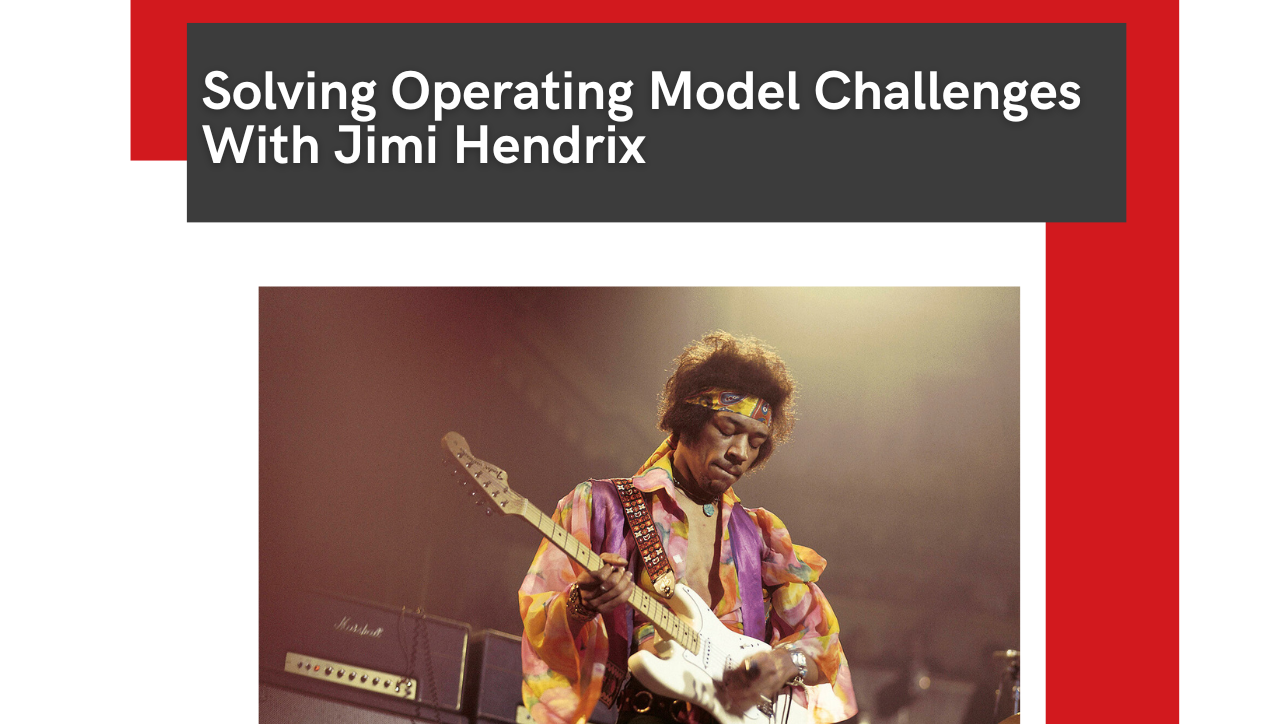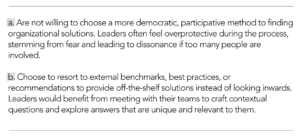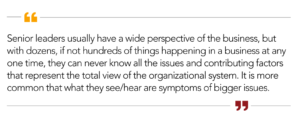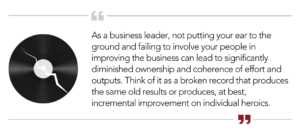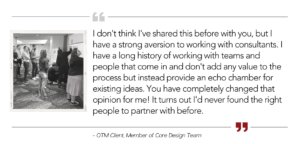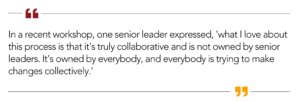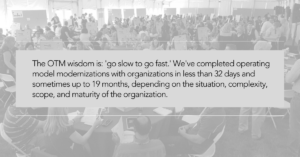7 Minute Read
Takeaway: We can all take a page out of Jimi Hendrix’s playbook. In fact, senior business executives can take a pretty large chunk out of Hendrix’s playbook… Jimi Hendrix was an artist and musician who fed off the energy of his audience and involved them in his work. The art of “jamming” lies in each player’s ability to transfer control and creativity to one of their bandmates. It takes many hours of practice, participation, and informal collaboration for a coherent soundtrack to emerge. Similarly, we see this during operating model modernizations! It may require more effort up-front, but in the end, you’ll have the magnificent cadence, harmony, and rhythm that is needed for a business to deliver its value-creating work.
A recent article from HBR stated only 10% of organizations are successful at aligning their strategy with their operating model. Let’s face it, organization redesign can be overwhelming for business leaders. The standard approach is to exert control over the redesign process, do things top-down, or rely on off-the-shelf benchmarks.
Often there is an urge to react to a threat, risk, or opportunity, instead of taking time to test and refine the solution to address the root cause.
Predictably, half-baked solutions often live and die on presentation decks with no real behavior change, and sometimes, they may lead to unintended drops in performance for the organization.
The situation becomes even murkier when business leaders:
The question that arises is, “How can business leaders enable highly relevant and sticky solutions, where the ideas come from truly listening to the pulse of the workforce?”
The most effective operating model modernization happens when a well-disciplined process meets a group’s pace and the level of truth and understanding that the group is willing to engage in. That dance is what creates magic.
My first 6 months at ON THE MARK have taught me that collaborative, involve-and-do methods deliver exponentially better results than the usual sell-and-tell approach; generating fast and effective adoption of new solutions. This requires the right balance of leadership, direction setting, a disciplined process, and conditions to develop trust within a group.
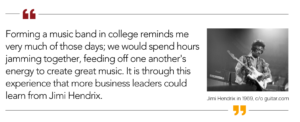 Involve Your People Whole-Heartedly.
Involve Your People Whole-Heartedly.
“Technically, I’m not a guitar player, all I play is truth and emotion.” – Jimi Hendrix
The ability to connect with one’s truth and emotion and channel that can be empowering and impactful. However, leaders often feel uncomfortable opening more issues than they can handle at any one time, or exposing the leader’s own imperfections. They fear several negative outcomes: frustration as the group is too large to accomplish anything meaningful, too many ideas and actions are generated making it difficult to prioritize, and chaotic behavior as people fight to have their voices heard. The key is the freedom to participate. Involving the workforce requires discipline and structure.
Amongst all this ‘busyness’ it is tempting to exert knowledge and control, resulting in leaders doing most of the thinking for their team. That is not sustainable, nor is it a means of leveraging the collective intelligence of a group. It also results in a one-way dialogue where those at the top are seen to regularly synthesize data and present answers, fixes, and solutions. But organizational reality suggests that the recipients of such direction struggle to make sense of the direction. They either desperately want to share critical missing information, or constructively challenge the solution.
Without a mechanism or the psychological safety to do so, we often see ’consent and evade‘ behavior. The larger portion of the workforce may hear what is being said and superficially consent, but do not execute because they don’t believe in the viability of what is being asked. The organization ends up being stuck between leaders who believe they’ve given clear direction and a workforce who fail to fully implement it. You might imagine it as a rather large ’not invented here‘ effect.
The Art of a Jam Session: Active Collaboration
Jimi Hendrix was an artist because he fed off of his audience and involved them in the entire experience. The art of jamming rests in each player’s ability to transfer control and creativity to one of their bandmates. It takes many hours of practice, participation, and informal collaboration for a coherent soundtrack to emerge.
At the end of a recent two-day workshop, a team member turned to the senior leaders and said, “Thank you for being so inclusive and providing a truly safe space.” The leadership team left the workshop with 23 interconnected issues and a prioritized list of 4 to tackle. None of the 4 were part of the leadership team’s original issues. It was powerful for me to experience cross-pollination within a diverse group to generate breakthrough ideas. They were able to challenge legacy assumptions with respect and humility, as well as define new possibilities.
Be Humble and Look Inside – The Answers Lie Within.
“Knowledge speaks, but wisdom listens.” – Jimi Hendrix
Every high-performing leader needs a good amount of humility. The resources leaders invest to listen to their employees’ needs reflect the importance they place on listening.
The challenge is moving beyond superficial listening. For many consecutive years, Gallup has reported low results when employees are asked to rate the statement, “My opinion counts.’
When evaluating an operating model, business leaders often struggle to find the ‘ideal solution.’ Many turn outward to consultancies or benchmarks to find out what everyone else is doing. This recent quote from an OTM customer is not the first time we have heard leaders describe consultants as being an echo chamber:
I have learned to appreciate OTM’s underlying belief that an organization already has all the knowledge it needs to design itself out of any challenge or to capitalize on an opportunity. The challenge is how leaders unlock that latent knowledge and bring it together for collective gain.
Holding well-designed participative dialogue sessions creates a sound foundation for enabling shared reflections that lead to real change.
My fondest days of playing music were when my fellow band members could pick up three or four instruments and play recognizable tunes. They had spent many years of practice to attain true musical wisdom. I remember a time our guitarist asked me to hold his guitar and continue to play the chord sequence. Meanwhile, he went to our drummer to show him a rhythm that was on his mind. The fact that the drummer freely gave up the sticks to be shown something different demonstrated our openness and flexibility.
I appreciate that it’s the same principle in OTM’s design work. For instance, helping a large team learn how to work and behave differently with each other; reaching a point where everyone is willing to have their lived experience and worldview fundamentally challenged. That is something we work hard to develop during the process. Frankly, there is no magical off-the-shelf solution to unlock this high level of group development, trust, wisdom, and genuine learning.
Go Slow To Go Fast.
“We have time, there is no big rush.” – Jimi Hendrix
It’s important to build and sustain momentum during any modernization of an operating model. The element of timing is crucial! If you delay and stretch the process. it loses steam and feels like a drag. But rushing to complete the process results in pushing solutions at people in a compressed period. This only allows for people to nod their heads and get on with it – consent and evade. We call this compliance-based change.
The wisdom relates to the upstream work in any redesign process. The dilemma is the urgency to ‘do something different’ in response to a threat, risk, or opportunity. The trade-off comes down to how you define success. Success in some leaders’ eyes favors a technical solution that is designed quickly, to give people reassurance. Yet the result is potentially weeks or months of traditional change management activity to gain compliance. The alternative is investing more time upfront and involving people, with cross-representation of the organization. This helps to align both the technical solution and the social system. By the time ‘implementation day’ arrives, a critical mass of representatives have been involved and are committed to what’s coming.
Creating Meaningful Outcomes
At OTM, we are constantly inspired by the sheer courage, openness, and commitment leaders bring to the table. It’s that collaborative and honest environment that creates impactful operating model outcomes. The common ingredients I have observed so far take direct inspiration from Hendrix:
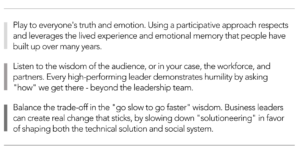 Just like Hendrix who touched the heart, mind, and soul through his lyrics and music, I’m blessed to have the opportunity to genuinely create impact and change paradigms. That’s how we do it at ON THE MARK.
Just like Hendrix who touched the heart, mind, and soul through his lyrics and music, I’m blessed to have the opportunity to genuinely create impact and change paradigms. That’s how we do it at ON THE MARK.
Rahul Lama is a Support Consultant at ON THE MARK. OTM is a global leader in collaborative operating model modernization that creates real change, fast. OTM’s passion for collaborative business transformation is supported by pragmatism, systems thinking, and a belief in people that is unparalleled for 33 years.

